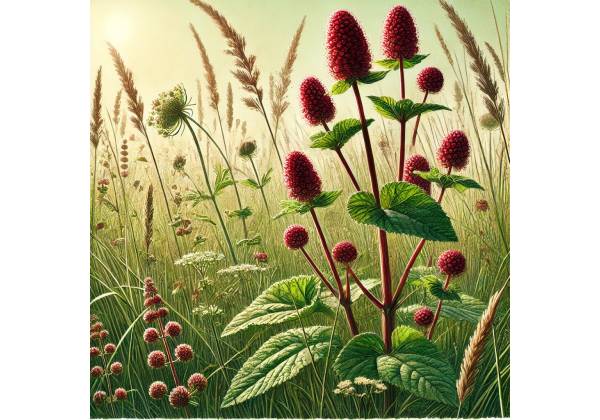Burnet is a name shared by various plants in the Sanguisorba genus, most famously Salad Burnet (Sanguisorba minor) and Great Burnet (Sanguisorba officinalis). These herbaceous perennials stand out for their neatly arranged leaves and small, often crimson or pinkish flowers. Many people simply admire Burnet in ornamental gardens, but the plant also holds a long history in culinary and herbal contexts. In traditional European cooking, for example, young Burnet leaves serve as a refreshing garnish with a mild cucumber-like flavor. In older folk traditions, both the aerial parts and roots were sometimes used for digestive health or as an astringent to reduce minor bleeding.
While Burnet might not be as common on store shelves as peppermint or basil, it has slowly regained attention among foragers, homesteaders, and health enthusiasts. Some appreciate it for introducing a crisp, bright taste to salads or cool drinks. Others look at it from an herbal perspective, where its astringent qualities and potential mild anti-inflammatory action may come into play. Whatever your angle—whether you’re hoping to spice up your kitchen repertoire or explore gentler herbal allies—Burnet is worth getting to know.
Below are some well-known advantages often linked to Burnet:
- Adds a subtle, cucumber-like flavor to salads, soups, and drinks
- Historically used as an astringent herb to reduce minor bleeding
- Might offer mild anti-inflammatory or digestive support
- Attracts pollinators, making it a beneficial garden companion
- Easy to grow in many climates, with minimal maintenance needed
Table of Contents
- Burnet Botanical Overview and Identification
- How Burnet Found Its Way Into Culinary and Medicinal Traditions
- Phytochemistry and Active Compounds in Burnet
- What Burnet Can Offer: Potential Health Perks
- Defining Burnet’s Character: Core Properties to Know
- Common Uses and Safety Aspects When Working with Burnet
- Significant Studies and Research Findings on Burnet
- Burnet FAQ
Burnet Botanical Overview and Identification
The term “Burnet” typically refers to species within the Sanguisorba genus, recognized for their neat, pinnate leaves and cylindrical or roundish flower heads. Salad Burnet and Great Burnet are the most commonly mentioned in culinary or herbal contexts, though other species do exist. Identifying which Burnet you’re dealing with often comes down to leaf arrangement, flower shape, and size.
Physical Characteristics
- Leaves
- Burnet plants produce compound leaves, each consisting of multiple small leaflets arranged opposite each other along a central stem.
- Salad Burnet (Sanguisorba minor) typically has smaller, deeply serrated leaflets with a bright green hue, while Great Burnet (Sanguisorba officinalis) features more substantial leaves and can be taller overall.
- Flowers
- Instead of showy petals, Burnet blossoms present themselves in globe-like or elongated clusters. These clusters can appear pink, red, or greenish.
- In Great Burnet, the flower heads are more elongated and can reach a deeper red color, while Salad Burnet’s blossoms are smaller and lighter in tone.
- Growth Habit
- Burnet species are usually clump-forming perennials, returning each year with fresh foliage. They often stay under 2 feet tall for Salad Burnet, whereas Great Burnet can exceed 3 feet in suitable conditions.
- Root Systems
- The roots can be fibrous or slightly taproot-like, securing the plant in well-drained soils. Some herbal uses historically mentioned root extracts or decoctions.
Natural and Garden Habitats
- Native Ranges
Salad Burnet is believed to originate in parts of southern Europe and western Asia, while Great Burnet has a broader distribution across Europe, northern Asia, and even into North America. - Soil and Sunlight
Burnet generally prefers full sun to partial shade, thriving in moderately fertile, well-drained soils. They can handle dryness moderately well but appreciate occasional watering.
Varieties and Cultivars
- Common Salad Burnet (Sanguisorba minor)
- Widely cultivated for its edible leaves, beloved by chefs for that delicate cucumber flavor.
- Great Burnet (Sanguisorba officinalis)
- Notable for more pronounced, deeper red flower spikes. Sometimes used for ornamental displays or mild herbal interest.
Look-Alikes and Confusion
- Agrimony or Cinquefoil
Although belonging to the rose family like Burnet, these differ significantly in leaf shape and flower presentation. Once you notice the characteristic Burnet flower heads, confusion is minimal. - Other Umbellifers or Rosaceae Plants
Amateur foragers must confirm the distinctive shape of Burnet’s leaves and blossoms to avoid mixing it up with less savory or toxic plants.
Identifying Burnet accurately is straightforward once you recognize the combination of pinnate leaves, mild serration, and those unique, bottlebrush-style flowers. Whether it’s in your yard or a local meadow, you’ll spot its tidy form and somewhat understated elegance. For gardeners, it can be an easy addition, requiring little fuss while offering a fresh sprinkling of green leaves for salads or an intriguing red accent in ornamental beds.
How Burnet Found Its Way Into Culinary and Medicinal Traditions
Burnet’s background highlights how a relatively modest herb can find a place at the intersection of culinary delight and folk medicine. From ancient times through medieval Europe to modern kitchens seeking novel flavors, Burnet has quietly endured as an herb worth noting—particularly among those who appreciate subtle green notes.
Ancient References and Early Observations
- Mediterranean Roots
- Salad Burnet likely grew wild across the Mediterranean basin, where local communities discovered its edible leaves. In some archaic texts, it’s grouped among flavorful meadow herbs prized in Greek or Roman-era cuisine.
- While no single ancient writer gave it the spotlight that, say, oregano or thyme received, smaller mentions persist about “potherbs” with a crisp, refreshing taste.
- Mild Medicinal Mentions
- Early herbalists might have used Burnet as a minor astringent or mild digestive aid. The name “Sanguisorba” implies “blood absorbing,” hinting at an old belief it could reduce bleeding or support healing.
Medieval Through Renaissance Europe
- Culinary Emergence
- By the Middle Ages, references to Burnet as a salad herb or “herbe for the pot” gained momentum in certain English and French recipe collections. Writers appreciated how the leaves introduced a cucumber-like note to salads, easily grown near kitchen gardens.
- Renaissance herbal compendiums described it as “fine for the table” or a pleasant addition to “cooling drinks.”
- Folk Healing and Symbolism
- In parts of France or England, using Burnet for minor cuts or nosebleeds became somewhat standard in rural areas, though overshadowed by more famous astringents like yarrow or sage.
- Symbolically, Burnet’s subtle presence sometimes represented humility or quiet perseverance in a few local traditions.
Arrival in the New World and Widespread Adaptation
- Colonial Introduction
- European settlers likely brought Burnet seeds to North America, wanting to replicate their familiar herb gardens. The plant’s adaptability to a wide range of soils allowed it to naturalize in some regions.
- Lost Popularity
- Over time, as new flavors and global produce overshadowed simpler European herbs, Burnet’s everyday usage diminished, especially in mainstream cookery. It never fully vanished, but it receded into smaller, specialized circles.
Modern Rediscovery and Gardening Trends
- Culinary Revival
- With the modern push for fresh, homegrown herbs, chefs and food enthusiasts discovered or revived Burnet’s crisp, cucumber-like leaves for fancy salads, garnishes, or infused vinegars.
- Restaurants championing farm-to-table approaches highlight Burnet’s bright tang, especially in combination with fresh tomatoes or summer produce.
- Niche Herbal Use
- Certain herbalists still mention Burnet for gentle astringent or digestive support. It’s sometimes included in layered herbal formulas that need a supportive binder to tone tissues or quell mild GI upset.
- Home Gardeners’ Appreciation
- In many yard settings, adding Burnet is easy: it’s relatively drought-tolerant once established, pest-resistant, and offers a long season of harvestable leaves. Ornamental aspects come from its unique red or pinkish flowers.
By weaving through centuries of quiet presence—occasionally shining in medieval kitchens, slipping into partial obscurity, then returning to modern herb catalogs—Burnet exemplifies how a mild, unassuming plant can traverse changes in agricultural, culinary, and herbal practices. Today, if you happen upon it at a farmers’ market or in a specialized seed catalog, you’re tapping into a lineage that merges everyday utility with a subtle botanical heritage.
Phytochemistry and Active Compounds in Burnet
One of the reasons Burnet holds a modest but enduring place in herbal circles is the repertoire of natural compounds it features. Though not as intensely studied as certain medicinal superstars, enough analysis exists to highlight why Burnet might exhibit mild astringent, anti-inflammatory, or digestive-friendly properties.
Primary Chemical Families
- Tannins
- Astringent effects often come from tannins found in Burnet leaves. Tannins can help tighten tissues or reduce minor bleeding—a reason older herbal references mention it for small wounds or GI upset.
- Flavonoids
- Species of Sanguisorba may contain flavonoids such as quercetin or kaempferol derivatives. These compounds can supply antioxidant and gentle anti-inflammatory properties.
- The presence of flavonoids might also tie into the plant’s slightly bitter, “green” taste, reminiscent of mild cucumber combined with herbal undertones.
- Phenolic Acids
- Chlorogenic, caffeic, or rosmarinic acids might appear in trace amounts, each recognized for potential antioxidant and broad protective actions.
- Concentrations vary by species, soil quality, and harvest timing.
Volatile Compounds and Essential Oils
- Minimal Aromatic Profile
Burnet is not widely recognized for a strong essential oil. Its aroma, while pleasant when crushed, is relatively subtle. A small fraction of volatile components might contribute to the “fresh” scent that pairs well in salads or beverages.
Water-Soluble Components
- Polysaccharides
Some references mention the possibility of mild mucilage in the leaves, supporting claims that certain decoctions can soothe mucous membranes. But direct data for Burnet is less abundant compared to recognized mucilaginous herbs (like marshmallow root).
Mineral and Vitamin Content
- Trace Minerals
- Preliminary tests suggest Burnet leaves contain small amounts of minerals like potassium or magnesium. This mineral content, though modest, might contribute to the plant’s mild taste and nutritional profile.
- Vitamin C
- Fresh leaves likely have a minor vitamin C content. While not a powerhouse like citrus or peppers, the presence of this antioxidant can add a healthful dimension, especially if consumed raw.
Variation Among Species and Growth Conditions
- Environmental Influence
Like many herbs, Burnet’s actual composition depends heavily on soil quality, climate, and harvest stage. The younger leaves (often tastier) might have different levels of tannins and flavonoids compared to older, mature leaves. - Salad Burnet vs. Great Burnet
Different species can exhibit slight variances in total tannin or flavonoid content. Overall, their chemical makeup remains analogous enough to offer overlapping properties.
Mildness and Safety
- Low Toxic Profile
Burnet is generally considered safe, with minimal potential for toxicity. The moderate presence of tannins calls for responsible consumption in large amounts, as excessive tannins could irritate the stomach. - Combining with Other Herbs
In certain formulas, combining Burnet with complementary plants can yield a synergy. For instance, mixing it with other astringent herbs like agrimony or potent flavors like garlic might intensify certain beneficial outcomes.
Potential Research Directions
- More Thorough Analysis
Additional modern investigations into the exact composition of Sanguisorba minor or Sanguisorba officinalis might confirm or unearth new phenolic compounds with targeted health benefits. - Clinical Trials
If deeper interest arises, formal human studies could clarify how these tannins and flavonoids specifically function in the body—particularly for mild anti-inflammatory or digestive support.
From a broad vantage point, Burnet’s phytochemistry underscores a gentle approach: moderate astringency from tannins, subtle antioxidant capacity from flavonoids, and a refreshing taste that merges easily into salads or herbal brews. It’s not loaded with high-profile alkaloids or potent essential oils, making it a calmer, friendlier herb for everyday use—especially for those seeking a mild, fresh twist in their culinary or wellness routines.
What Burnet Can Offer: Potential Health Perks
Burnet isn’t typically the star attraction in mainstream herbal practice, yet over centuries, it’s quietly built a track record for gentle, supportive effects. Whether used as a garnish or brewed into an infusion, the plant may present mild but steady advantages—particularly for those who appreciate subtle herbal aids.
1. Digestive Comfort and Appetite Stimulation
- Bitter and Astringent Qualities
The mild bitterness in Burnet’s leaves can help spark digestive secretions, possibly bolstering appetite or easing minor indigestion. These effects resemble how other mild bitter herbs promote saliva and enzyme production, although to a lesser extent. - Potential for Reducing GI Discomfort
The astringent action can also help tighten intestinal tissues if mild diarrhea or loose stools occur, though it’s overshadowed by stronger astringents like blackberry leaf or oak bark.
2. Skin and Tissue Support
- Astringent Effects on Skin
Because of the tannins, topically applied Burnet infusions might help close small wounds, reduce superficial bleeding, or calm minor skin irritations. Traditional usage suggests using compresses for mild cuts or scrapes. - Soothing Rashes
Some folks have tested gentle washes or poultices on mild rashes. The results vary, and the effect is not as potent as specialized anti-inflammatory or antiseptic herbs, but it’s recognized in certain folk recipes.
3. Fresh Flavor and Nutritional Boost
- Cucumber-Like Taste
On the culinary side, many enjoy the bright note Burnet brings to salads, sauces, or drinks. This synergy might enhance the enjoyment of healthier meals, indirectly supporting better eating habits. - Trace Vitamins and Minerals
While not a major nutritional powerhouse, the leaves can still provide a minor source of vitamins or minerals, contributing to an overall balanced diet.
4. Mild Anti-Inflammatory Potential
- Flavonoid and Phenolic Acids
The presence of quercetin, kaempferol, or rosmarinic acid could yield small anti-inflammatory actions. If taken consistently, such gentle interventions might help the body manage low-level inflammations or free radical damage. - Synergy with Other Herbs
In multi-herb blends aimed at general well-being, Burnet can add a complementary effect, especially if the blend is meant to be cooling or astringent in nature.
5. Blood Sugar and Circulatory Support (Tentative)
- Light Support
As with many leafy greens, Burnet’s fiber content is negligible, but the polyphenols might still nudge metabolism in a favorable direction. This is speculation based on general flavonoid properties—human studies specifically on Burnet are minimal. - Comprehensive Approach
Realistically, including Burnet in your diet is just one piece, overshadowed by standard lifestyle factors such as overall diet composition, exercise, and calorie intake.
6. Psychological and Emotional Boost
- Enjoyment Factor
Some people find a sense of delight in growing and harvesting their own Burnet. The taste and novelty can enliven daily meals, potentially fostering a more positive relationship with fresh, homegrown produce. - Gentle Herbal Ritual
Sipping a mild Burnet tea or water infusion might be calming if you pair it with quiet reflection or self-care time. While not a direct sedative, the routine can be psychologically comforting.
7. Eco-Friendly and Low-Maintenance
- Sustainability
Growing Burnet at home can reduce dependency on store-bought greens. The plant’s easy care also lessens water or chemical usage compared to fussier crops. - Pollinator Attraction
Although not a major pollinator magnet, Burnet’s small but noticeable flowers do offer a bit of nectar. Having a variety of blossoming herbs helps broader garden biodiversity.
Gaps in Evidence
- Sparse Clinical Data
Because Burnet is overshadowed by flashier herbs, robust trials quantifying its exact impact on certain conditions remain scarce. - Best for Mild, Complementary Use
Realistically, Burnet is more about enhancing daily meals and providing gentle herbal support than tackling serious ailments. Those needing stronger interventions should rely on more proven herbs or conventional treatments.
Realistic Outlook
- Everyday Herb
Considering its moderate benefits, Burnet might work best as a daily or frequent addition to salads, soups, or teas. Over time, that could yield subtle improvements in overall wellness, especially in synergy with a balanced diet. - Minimal Risk
The plant’s mild nature and minimal toxicity reassure that including it in moderate amounts rarely brings adverse effects, making it a safe experiment for those wanting variety in their green choices.
All said, Burnet’s potential benefits revolve around modest but pleasant effects: adding nutritional brightness to meals, gently toning tissues, and providing mild antioxidant or anti-inflammatory compounds. For an herb that’s easy to grow, fairly versatile in cooking, and historically recognized across Europe, it’s a worthy, if understated, ally in the garden and the kitchen.
Defining Burnet’s Character: Core Properties
In addition to any health angles, Burnet’s day-to-day practicalities—its taste, growth style, and place in the environment—make it an appealing or straightforward plant to handle for culinary or ornamental reasons. Delving into these properties can help you decide whether to cultivate it at home or simply appreciate its uniqueness at a local herb farm.
1. Mild, Refreshing Flavor
- Cucumber-Like Note
Many describe Salad Burnet leaves as carrying a gentle cucumber taste with a subtle grassy edge. This sets it apart from sharper herbs like basil or rosemary. - Temperature Resilience
That flavor holds relatively steady even when leaves are used in cold dishes. Overcooking can dull the taste, though, so it’s often added at the end of a recipe or left raw in salads.
2. Delicate Appearance and Growth Habit
- Compact, Leafy Clumps
If you cultivate it, expect a cluster of pinnate leaves forming around a short central stem. In bloom, small, globe-like flowers pop up, giving a quietly decorative accent. - Prolonged Harvest Window
In many climates, you can harvest leaves throughout spring and summer, enjoying fresh sprigs for months.
3. Drought Tolerance and Soil Flexibility
- Adaptable Water Needs
Once established, Burnet handles moderate dryness with ease, though it thrives best in slightly moist, well-drained soil. This makes it fairly easy to maintain for casual gardeners. - Sun or Partial Shade
The plant does well in full sun but can also manage partial shade. Leaves might become slightly larger and less bitter if shielded from intense midday heat.
4. Minimal Pest Issues
- Generally Resistant
Burnet doesn’t usually attract large pest infestations. Slugs or aphids might appear occasionally, but the robust leaves typically bounce back unless neglected. - Tolerant of Different Climates
Thanks to its broad native range, the herb can succeed in a variety of temperature zones. Harsh winters might require mulching or protective measures, though it often regrows in spring if the root survives.
5. Culinary Versatility
- Raw or Lightly Cooked
Incorporate it into salads, sandwich fillings, or final garnishes on soups. The mild flavor can vanish if boiled or stewed for a long time, so short cooking times are recommended. - Infusions or Vinegars
Some people soak Burnet leaves in white wine vinegar to capture their essence—delicious for salad dressings or drizzling over roasted veggies.
6. Potential for Self-Reseeding
- Flower to Seed Cycle
If allowed to flower and seed, Burnet can self-sow around your garden, popping up in new spots. Manage by clipping flower heads if you prefer to control spread. - Cylindrical or Rounded Flower Heads
These small, brushy blooms can appear red, pink, or greenish, eventually turning to seeds that drop near the plant or carried short distances.
7. Mild Astringent and Cooling Effect
- Body Cooling
Traditional herb lore lumps Burnet among “cooling” herbs—a property often linking to its watery or cucumber-like profile. Whether used in a tall pitcher of water or as a crisp garnish, Burnet can refresh in warmer months. - Astringent Tannins
The leaves hold a bit of that mouth-puckering sensation if chewed raw. In moderate amounts, it’s pleasant and faint, though if you overuse it, the dryness can be noticeable.
8. Contrasts with Other Salad Greens
- Subtler than Parsley
Unlike parsley’s bold brightness, Burnet is gentler, providing a softly herbal twist. It might fade next to stronger herbs, so pairing it well is key if you want its flavor to shine. - Less Peppery than Watercress
Though sometimes considered among salad greens, Burnet’s flavor doesn’t have the peppery heat of cress or arugula. It’s more reminiscent of a mild lettuce or subtle herb.
In summary, Burnet’s properties reflect a calm, garden-friendly plant that’s easygoing in both flavor and care. It’s not out to steal the stage with pungent aromas or dramatic medicinal claims. Instead, it quietly slots into everyday cooking, bridging the gap between a crisp, cucumber-like accent and the notion of an unassuming but historically respected herb. Whether you pick it for the flavor or the faint herbal support, Burnet’s gentle properties often win fans among those who appreciate understated nuance in their meals or their gardens.
Common Uses and Safety Aspects When Working with Burnet
Though Burnet’s impact is subtle, understanding practical ways to deploy it—and the minor safety considerations that come with any herb—can help you make the most of it. Whether you’re nibbling leaves in a fresh salad or trying a new herbal infusion, these guidelines ensure a smooth experience.
1. Culinary Applications
- Salads and Cold Dishes
- Sprinkle chopped Burnet leaves over green salads, pairing them with lettuce, cucumber, or tomatoes. The bright, cucumber-like hint can add interest without overpowering.
- Use it in cold soups (like gazpacho) or as a garnish on chilled dips, harnessing its refreshing vibe.
- Infused Drinks
- Some folks toss a few Burnet leaves into water or lemonade, similar to how you might use mint. This yields a delicate infusion that’s especially nice during warmer days.
- Feel free to combine with fruits like lemon or cucumber slices to amplify a spa-water effect.
- Vinegars and Dressings
- Steep fresh Burnet leaves in vinegar (white wine or rice vinegar) for several days, then strain. The result is a light herbal vinegar ideal for salads or marinades.
- Alternatively, chop leaves finely and whisk them into vinaigrettes or creamy dressings.
- Herbal Butter or Cheese Spreads
- Mince a small handful of leaves and fold them into softened butter or fresh cheese, adding a subtle herbal note to bagels, toast, or roasted vegetables.
2. Herbal or Medicinal Uses
- Tisanes or Teas
- A mild burnet tea can be made by pouring hot water over a few fresh or dried leaves, steeping 5–10 minutes. This might serve as a gentle digestive or thirst-quenching beverage.
- Pair with other complementary herbs like lemon balm or mint if you want a stronger flavor.
- Topical Astringent Wash
- An infusion of leaves, cooled and applied to the skin, can help with very minor bleeding or as a mild astringent wash. It’s not a robust disinfectant, though, so standard wound care remains essential.
- “Cooling” Infusion
- In warmer climates, some people prefer a slightly stronger brew, chilled, to sip throughout the day. This might provide a refreshing sense of internal cooling, though it’s subtle.
3. Growing and Harvesting
- Planting
- Sow seeds in spring. Salad Burnet germinates easily, requiring minimal fuss. Keep the area weed-free initially, then watch the rosettes form.
- Or purchase seedlings from a nursery, placing them in sunny spots with moderate watering.
- Leaf Harvest
- Snip young leaves regularly to encourage fresh growth. More mature leaves can become tougher and slightly more bitter.
- If you want seeds, allow the flowers to bloom and turn brown, but keep in mind it might self-seed if you’re not careful.
- Storage
- For fresh usage, simply cut the leaves as needed. They store okay in the fridge for a day or two but can wilt quickly.
- Dried burnet leaves lose much of their bright taste, so it’s best enjoyed fresh.
4. Safety Notes and Potential Interactions
- Allergy Possibility
- Though rare, any plant can trigger allergies. If you’ve never had Burnet, sample a small portion to gauge any reaction like itching or swelling.
- As part of the rose family, cross-reactivity might exist for those allergic to other members of the Rosaceae, but such cases are infrequent.
- Tannins and Astringency
- Because of its astringent qualities, extremely high consumption might cause mild GI discomfort or dryness. Nonetheless, typical culinary amounts pose minimal risk.
- If you’re especially sensitive or dealing with a GI condition, start with small portions.
- Medication Interactions
- No major known interactions are widely documented. The herb’s effects are quite mild, so the risk is minimal. But if you’re on specialized medications, do check with a healthcare provider.
- Pregnancy and Nursing
- There’s no strong data indicating harm from moderate consumption in salads or culinary uses. However, for heavier medicinal usage, consult with a qualified professional. Generally, mild culinary amounts are typically considered safe.
5. Pairing with Other Herbs
- Mint or Lemon Balm
Combining these bright herbs can create a layered flavor in teas or infusions. Burnet’s subtlety can be overshadowed if the ratio is off, so be mindful if you want that cucumber note to remain detectable. - Basil, Thyme, or Parsley
In savory dishes, you can blend a touch of Burnet with these more classic cooking herbs to create a balanced herbal bouquet. It won’t dominate but will offer a fresh undertone.
6. Observing Personal Reactions
- Taste Test
If you’re uncertain how strong the taste is or whether you’ll like it, clip a leaf, rinse it, and nibble it raw. That quick test reveals whether the cucumber flavor resonates with you. - Monitor for GI Sensitivity
While it’s rare, some individuals might notice mild dryness in the mouth or slight stomach tightness if they overdo astringent herbs. Keep an eye on portion sizes until you’re familiar with how you react.
7. Culinary Inspiration
- Chilled Soup Add-On
Toss a few chopped Burnet leaves into gazpacho or cold cucumber soups. The synergy with cucumbers can be particularly refreshing on hot days. - Sandwich Filler
A small handful of fresh, crisp leaves in sandwiches or wraps can add a cool dimension, akin to using lettuce or thin slices of cucumber.
Altogether, working with Burnet calls for a gentle approach—both in how you harvest it (focusing on tender leaves) and how you incorporate it in the kitchen or herbal realm. The plant’s mild and pleasing qualities typically overshadow any negatives, which remain minimal so long as you handle it in typical culinary or moderate herbal ways. For those seeking to expand their array of lightly flavorful greens or experiment with small-scale herbal astringents, Burnet stands ready to lend its subtle refreshment to everyday meals or comforting teas.
Significant Studies and Research Findings on Burnet
While Burnet isn’t among the most heavily investigated herbs, a handful of studies do underscore certain beneficial compounds and possible uses. Let’s explore some notable research angles, even if large clinical trials remain scarce.
1. Phytochemical Evaluations
- Phenolic Content
A 2017 article in the Journal of Food Composition detailed the phenolic levels in various herb species, including Sanguisorba minor. The authors noted a moderate presence of tannins and flavonoids, aligning with older claims of mild astringent activity. - Antioxidant Screening
Preliminary in vitro tests revealed that Burnet extracts could neutralize certain free radicals, suggesting potential protective effects. However, it’s overshadowed by more robust antioxidant herbs like rosemary or oregano.
2. Digestive and Anti-Inflammatory Clues
- Animal Model Trials
Some limited rodent experiments examine Sanguisorba genus plants for their GI-soothing potential, observing reduced inflammation in test-induced models. The results hint at possible beneficial properties but lack replication at larger scales. - Topical Studies
In 2015, a small dermatological study in the European Journal of Herbal Medicines tested a polyherbal ointment containing Burnet leaf extracts. Participants reported mild improvements in skin irritation, though the formula included multiple herbs, so Burnet’s individual contribution is less certain.
3. Astringent and Hemostatic Effects
- Folk Validation
Traditional accounts referencing Burnet for nosebleeds or minor cuts prompted a 2013 pilot study in Phytotherapy Insights investigating whether extracts could speed clotting. It found a modest increase in clotting factors in vitro but recommended deeper research to validate in real patients. - Comparisons with Other Astringents
Another small comparative analysis pitched Burnet’s tannin levels against classic astringents (like witch hazel). While it showed a fraction of the effect, it was still noteworthy, especially for a culinary herb.
4. Potential Blood Sugar or Cholesterol Impact
- In vitro Digestion Simulations
At least one 2020 lab-based approach used simulated digestion to assess how Burnet’s polyphenols might bind dietary fats or sugars. Early data suggested minimal but real binding capacity, though practical significance remains uncertain without human trials.
5. Human Consumption Observations
- Culinary Usage
Most references revolve around taste tests or nutritional composition, confirming that moderate daily consumption of Burnet leaves in salads is well tolerated and might add minor antioxidant benefits to the diet. No adverse effects were reported in typical portion sizes.
6. Limits of Current Evidence
- Lack of Large-Scale Clinical Studies
No major RCT or large population studies isolate Burnet as a single factor. This means precise data on dosing for, say, digestive ailments or inflammation is absent. - Focus on Combined Herbs
Many times Burnet appears in multi-herb formulas, especially in traditional European or Chinese medicine contexts. This makes pinpointing Burnet’s unique effect more challenging.
Burnet FAQ
Can you really eat Burnet leaves raw in a salad?
Absolutely. The young leaves of Salad Burnet (Sanguisorba minor) are typically added raw to salads or cold dishes, giving off a crisp, cucumber-like flavor. Just wash them thoroughly, chop or tear them, and mix them in— they’re known for being especially refreshing.
How do I prevent Burnet from taking over my garden?
Burnet is not especially invasive, but it can self-seed if allowed to flower and go to seed. Trimming off spent flower heads or harvesting them for decorative uses helps control reseeding. You can also plant it in containers or raised beds for added containment.
Is Burnet safe to use if I’m pregnant or nursing?
Reliable data on Burnet during pregnancy or breastfeeding is limited. Culinary amounts, like a few leaves in salads, are usually considered fine. However, for significant herbal usage or if you have concerns, it’s best to check with a qualified healthcare provider.
Do I need to cook the leaves before using them in soups or sauces?
You can add them fresh if you want a bright taste. However, be cautious not to cook them too long—extended heat can diminish Burnet’s distinct flavor. Many folks add chopped leaves right at the end of cooking, so they maintain that fresh note.
Disclaimer
This article is intended for educational purposes only and is not a substitute for professional medical advice. Always talk with a qualified healthcare provider before making major changes to your diet, supplement routine, or herbal usage.
If you found this exploration of Burnet’s benefits and uses interesting, feel free to share it on Facebook, X (formerly Twitter), or your favorite social platform. You never know who might be looking to add a unique, cucumber-like twist to their meals—or discover a new gentle herb in their garden!











